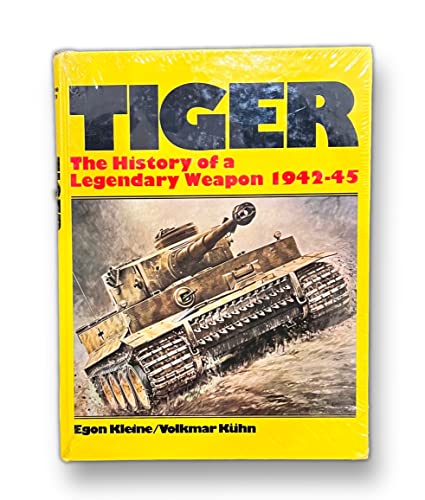Kleine Egon Kuhn Volkmar Johnston (2 results)
Product Type
- All Product Types
- Books (2)
- Magazines & Periodicals
- Comics
- Sheet Music
- Art, Prints & Posters
- Photographs
- Maps
- Manuscripts & Paper Collectibles
Condition
Binding
- All Bindings
- Hardcover (2)
- Softcover
Collectible Attributes
- First Edition (1)
- Signed
- Dust Jacket
- Seller-Supplied Images
- Not Print on Demand (2)
Free Shipping
- Free US Shipping
Seller Location
Seller Rating
-
Tiger: The History of a Legendary Weapon 1942-45
Published by J. J. Fedorowicz Publishing, Canada, 1989
ISBN 10: 0921991061ISBN 13: 9780921991069
Seller: Top Notch Books, Tolar, TX, U.S.A.
Book
Hard Cover. Condition: Very Good. No Jacket. Yellow pictorial boards have only light wear. Pages are clean, text has no markings, binding is sound. Prior owner name on fep. Size: Folio - over 12" - 15" tall. Ex Libris.
-
Tiger; The History of a Legendary Weapon 1942-45
Published by J.J. Fedorowicz Publishing, Winnipeg, Manitoba, Canada, 1989
ISBN 10: 0921991061ISBN 13: 9780921991069
Seller: Ground Zero Books, Ltd., Silver Spring, MD, U.S.A.
Book First Edition
Hardcover. Condition: Very good. ix, [1], 261, [1] pages. Oversized book, measuring 12 inches by 9-1/4 inches. Profusely illustrated with black and white illustrations and maps. Includes Translator's Notes, Appendix A--The German Panzerlied; Appendix B--Specifications--The Panzer VI Tiger I and II; Appendic C--Specifications--The Tank Destroyers Elefant and Jagdtiger; Appendix D--The Knight's Cross Holder of the German Tiger Arm; Appendix E--German Terms and Abbreviations; Bibliography, Photo Contributors. The material which forms the basis of this history of the battles and the final downfall of the legendary Tiger tank has been accumulated by the authors piece by piece since the end of the Second World War. The war diaries of several battalions were available, as well as individual diaries, letters, and evaluations. This is a classic on the Tiger I and Tiger II formations of the German Army and Waffen-SS. Even though the English-language edition of "Tiger, The History of a Legendary Weapon" is over 30 years old, it is still one of the best books written on the most feared tank of the Second World War. It is full of firsthand accounts that cannot be found anywhere else. The book covers the development history of the Tiger and continues with its introduction to battle near Leningrad. All the Army and Waffen-SS Tiger formations and the major battles they fought in are covered, from sPz.Abt. 501 in North Africa, through the struggles on the Eastern Front, to the fighting in the West, in Italy and in Hungary and ending with the final battles in Germany. Also included are unit histories of the Jagdtiger and Sturmtiger formations. Numerous firsthand accounts of combat in the Tiger are included in the text which give the reader a vivid insight into the reality of fighting in these massive vehicles. The numerous excellent photographs of the vehicles and their crews complement the text. The Tiger I, a German heavy tank of World War II, operated from 1942 in Africa and Europe, usually in independent heavy tank battalions. Its late war designation was Panzerkampfwagen VI Tiger Ausf. E. The early war variant was designated Panzerkampfwagen VI Tiger Ausf. H1. Often, people refer to both of the variants as Tiger. The Tiger I gave the German Army its first armoured fighting vehicle that mounted the 8.8 cm KwK 36 gun (derived from the 8.8 cm Flak 36). 1,347 were built between August 1942 and August 1944. After August 1944, production of the Tiger I was phased out in favour of the Tiger II. While the Tiger I has been called an outstanding design for its time, it has also been called over-engineered, using expensive materials and labour-intensive production methods. The Tiger was prone to certain types of track failures and breakdowns, and was limited in range by its high fuel consumption. It was expensive to maintain, but generally mechanically reliable. It was difficult to transport, and vulnerable to immobilization when mud, ice, and snow froze between its overlapping and interleaved Schachtellaufwerk-pattern road wheels, often jamming them solid. This was a problem on the Eastern Front in the muddy rasputitsa season and during periods of extreme cold. The tank was given its nickname "Tiger" by Ferdinand Porsche, and the Roman numeral was added after the later Tiger II entered production. The initial designation was Panzerkampfwagen VI Ausführung H (literally 'Armored Combat Wagon/Vehicle VI version H', abbreviated PzKpfw VI Ausf. H) where 'H' denoted Henschel as the designer/manufacturer. It was classified with ordnance inventory designation Sd.Kfz. 182. The tank was later re-designated as PzKpfw VI Ausf. E in March 1943, with ordnance inventory designation Sd.Kfz. 181. Today, only seven Tiger I tanks survive in museums and private collections worldwide. As of 2020 Tiger 131 (captured during the North Africa Campaign) at the UK's Tank Museum is the only example restored to running order. The Tiger II is a German heavy tank of the Second World War. The final official Germa.


